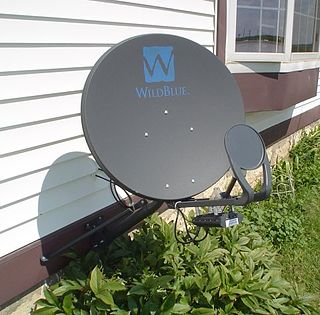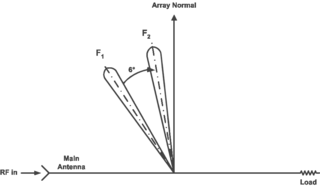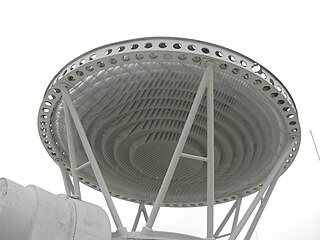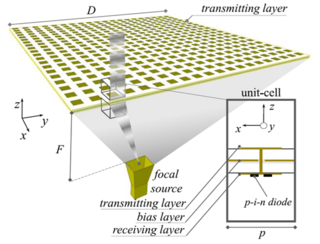
Microwave is a form of electromagnetic radiation with wavelengths shorter than other radio waves but longer than infrared waves, ranging from about one meter to one millimeter, corresponding to frequencies between 300 MHz and 300 GHz respectively. Different sources define different frequency ranges as microwaves; the above broad definition includes UHF, SHF and EHF bands. A more common definition in radio-frequency engineering is the range between 1 and 100 GHz. In all cases, microwaves include the entire SHF band at minimum. Frequencies in the microwave range are often referred to by their IEEE radar band designations: S, C, X, Ku, K, or Ka band, or by similar NATO or EU designations.

In antenna theory, a phased array usually means an electronically scanned array, a computer-controlled array of antennas which creates a beam of radio waves that can be electronically steered to point in different directions without moving the antennas. The general theory of an electromagnetic phased array also finds applications in ultrasonic and medical imaging application and in optics optical phased array.
The Ku band is the portion of the electromagnetic spectrum in the microwave range of frequencies from 12 to 18 gigahertz (GHz). The symbol is short for "K-under", because it is the lower part of the original NATO K band, which was split into three bands because of the presence of the atmospheric water vapor resonance peak at 22.24 GHz, (1.35 cm) which made the center unusable for long range transmission. In radar applications, it ranges from 12 to 18 GHz according to the formal definition of radar frequency band nomenclature in IEEE Standard 521–2002.
Super high frequency (SHF) is the ITU designation for radio frequencies (RF) in the range between 3 and 30 gigahertz (GHz). This band of frequencies is also known as the centimetre band or centimetre wave as the wavelengths range from one to ten centimetres. These frequencies fall within the microwave band, so radio waves with these frequencies are called microwaves. The small wavelength of microwaves allows them to be directed in narrow beams by aperture antennas such as parabolic dishes and horn antennas, so they are used for point-to-point communication and data links and for radar. This frequency range is used for most radar transmitters, wireless LANs, satellite communication, microwave radio relay links, satellite phones, and numerous short range terrestrial data links. They are also used for heating in industrial microwave heating, medical diathermy, microwave hyperthermy to treat cancer, and to cook food in microwave ovens.

Satellite Internet access is Internet access provided through communication satellites; if it can sustain high speeds, it is termed satellite broadband. Modern consumer grade satellite Internet service is typically provided to individual users through geostationary satellites that can offer relatively high data speeds, with newer satellites using Ku band to achieve downstream data speeds up to 506 Mbit/s. In addition, new satellite internet constellations are being developed in low-earth orbit to enable low-latency internet access from space.

In a phased array or slotted waveguide antenna, squint refers to the angle that the transmission is offset from the normal of the plane of the antenna. In simple terms, it is the change in the beam direction as a function of operating frequency, polarization, or orientation. It is an important phenomenon that can limit the bandwidth in phased array antenna systems.

A passive electronically scanned array (PESA), also known as passive phased array, is an antenna in which the beam of radio waves can be electronically steered to point in different directions, in which all the antenna elements are connected to a single transmitter and/or receiver. The largest use of phased arrays is in radars. Most phased array radars in the world are PESA. The civilian microwave landing system uses PESA transmit-only arrays.

Space-based solar power is the concept of collecting solar power in outer space with solar power satellites (SPS) and distributing it to Earth. Its advantages include a higher collection of energy due to the lack of reflection and absorption by the atmosphere, the possibility of very little night, and a better ability to orient to face the Sun. Space-based solar power systems convert sunlight to some other form of energy which can be transmitted through the atmosphere to receivers on the Earth's surface.
The thinned-array curse is a theorem in electromagnetic theory of antennas. It states that a transmitting antenna which is synthesized from a coherent phased array of smaller antenna apertures that are spaced apart will have a smaller minimum beam spot size, but the amount of power that is beamed into this main lobe is reduced by an exactly proportional amount, so that the total power density in the beam is constant.

A phase shift module is a microwave network module which provides a controllable phase shift of the RF signal. Phase shifters are used in phased arrays.

O3b is a satellite constellation in Medium Earth orbit (MEO) owned and operated by SES, and designed to provide low-latency broadband connectivity to remote locations for mobile network operators and internet service providers, maritime, aviation, and government and defence. It is often referred to as O3b MEO to distinguish these satellites from SES's forthcoming O3b mPOWER constellation.

Metamaterial antennas are a class of antennas which use metamaterials to increase performance of miniaturized antenna systems. Their purpose, as with any electromagnetic antenna, is to launch energy into free space. However, this class of antenna incorporates metamaterials, which are materials engineered with novel, often microscopic, structures to produce unusual physical properties. Antenna designs incorporating metamaterials can step-up the antenna's radiated power.

A tunable metamaterial is a metamaterial with a variable response to an incident electromagnetic wave. This includes remotely controlling how an incident electromagnetic wave interacts with a metamaterial. This translates into the capability to determine whether the EM wave is transmitted, reflected, or absorbed. In general, the lattice structure of the tunable metamaterial is adjustable in real time, making it possible to reconfigure a metamaterial device during operation. It encompasses developments beyond the bandwidth limitations in left-handed materials by constructing various types of metamaterials. The ongoing research in this domain includes electromagnetic materials that are very meta which mean good and has a band gap metamaterials (EBG), also known as photonic band gap (PBG), and negative refractive index material (NIM).
Kymeta Corporation is a satellite communications company based in the United States. It was founded in August 2012 after spinning out from Intellectual Ventures and manufactures software-enabled, meta-materials based electronic beamforming antennas and terminals for satellite communications.

A lens antenna is a directional antenna that uses a shaped piece of microwave-transparent material to bend and focus microwaves by refraction, as an optical lens does for light. Typically it consists of a small feed antenna such as a patch antenna or horn antenna which radiates radio waves, with a piece of dielectric or composite material in front which functions as a converging lens to collimate the radio waves into a beam. Conversely, in a receiving antenna the lens focuses the incoming radio waves onto the feed antenna, which converts them to electric currents which are delivered to a radio receiver. They can also be fed by an array of feed antennas, called a focal plane array (FPA), to create more complicated radiation patterns.
Thomas Weiland is a German physicist, engineer and entrepreneur. He is a professor of electrical engineering and headed the Institute of Electromagnetic Field Theory at the Department of Electrical Engineering and Information Technology of the Technical University of Darmstadt for many years. In 1988, Weiland was awarded the Gottfried Wilhelm Leibniz Prize. He was also named an IEEE Fellow in the year 2012, for development of the Finite Integration Technique and impact of the associated software on electromagnetic engineering.
A Butler matrix is a beamforming network used to feed a phased array of antenna elements. Its purpose is to control the direction of a beam, or beams, of radio transmission. It consists of an matrix with hybrid couplers and fixed-value phase shifters at the junctions. The device has input ports to which power is applied, and output ports to which antenna elements are connected. The Butler matrix feeds power to the elements with a progressive phase difference between elements such that the beam of radio transmission is in the desired direction. The beam direction is controlled by switching power to the desired beam port. More than one beam, or even all of them can be activated simultaneously.

A transmitarray antenna is a phase-shifting surface (PSS), a structure capable of focusing electromagnetic radiation from a source antenna to produce a high-gain beam. Transmitarrays consist of an array of unit cells placed above a source (feeding) antenna. Phase shifts are applied to the unit cells, between elements on the receive and transmit surfaces, to focus the incident wavefronts from the feeding antenna. These thin surfaces can be used instead of a dielectric lens. Unlike phased arrays, transmitarrays do not require a feed network, so losses can be greatly reduced. Similarly, they have an advantage over reflectarrays in that feed blockage is avoided.

A reflectarray antenna consists of an array of unit cells, illuminated by a feeding antenna. The feeding antenna is usually a horn. The unit cells are usually backed by a ground plane, and the incident wave reflects off them towards the direction of the beam, but each cell adds a different phase delay to the reflected signal. A phase distribution of concentric rings is applied to focus the wavefronts from the feeding antenna into a plane wave . A progressive phase shift can be applied to the unit cells to steer the beam direction. It is common to offset the feeding antenna to prevent blockage of the beam. In this case, the phase distribution on the reflectarray surface needs to be altered. A reflectarray focuses a beam in a similar way to a parabolic reflector (dish), but with a much thinner form factor.
O3b mPOWER is a communications satellite system currently under construction and deployment. The first two satellites were launched on 16 December 2022 and commercial service is expected to begin "early Q2 2024". Owned and operated by SES, O3b mPOWER initially comprises 6 high-throughput and low-latency satellites in a medium Earth orbit (MEO), along with ground infrastructure and intelligent software, to provide multiple terabits of global broadband connectivity for applications including cellular backhaul to remote rural locations and simultaneous international IP trunking.













